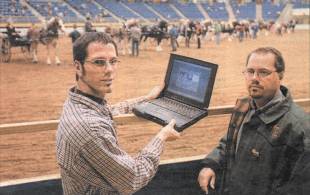 |
 |
Parsec Group Case Study:
The National Western Stock Show

|
In Colorado, the National Western Stock Show is a big deal. When Rick Kleinhans of PARSEC Group got his picture in the Denver Post newspaper for his role in bringing the Stock Show into the 21st century using Access and other Microsoft products, he was unprepared for celebrity. "A ten-year-old kid recognized me in a McDonald's in Winter Park", he said. "It felt weird."
|
| The National Western Stock Show began in a tent in 1906, and now includes world class rodeo competitions, and the National Western Horse Show, which had over 12,000 entries in the year 2000. Approximately 630,000 people attend the show annually, from all over the nation and more than 30 foreign countries. |
| PARSEC Group's project for the stock show began when the show's management realized their DOS-based databases and tracking systems were not Y2K compliant. Information was tracked in about 14 small databases, and when events were going on, the traditional way of relaying information was by "sneaker net". The National Western Complex covers 80 acres north of Denver, so a lot of people were staying in shape just getting information from one place to another. The complex consists of an Administration Building, the Events Center, a stockyard, and a stand-alone Employment Center about a quarter mile away from the heart of the show. Event management requested PARSEC Group send a team to upgrade the hardware and software, re-design their existing computer network and databases, and increasse the overall efficiency of their system. The team, consisting of James Allen, Paul Chambre, Rick Kleinhans, Ken Knapp, Mike Ross, and Brian Smith, and Barbara Valentine, began their work in July of 1999, and ended it in March of 2000. |
In 1999, it took 36 hours for contest results to get from events to the public. PARSEC Group converted the whole show to a Microsoft NT network, with clients using Windows 98, Office 97, and Microsoft Exchange to broadcast data throughout the organization. Because of these and other improvements, year 2000 event results from the arena were ready for the press and public in less than a third of the time.
|
| The Stock Show's old databases were flat, not relational, with a lot of redundancy. Initial mapping of the databases for redesign was a challenge - especially the horseshow database. This database, a version of the horse show industry standard "BestMess", was a dBase-type database housed in an Omni application on a standalone Macintosh computer. Rick couldn't access the code, and so had to deduce its inner workings from the GUI and results shown on reports. From this, he began a complete re-design, along with other team members, to convert to a relational database system. The careful analysis up front paid off - PARSEC Group's team was able to decrease the number of stand-alone databases and upgrade all remaining databases to Access in a SQL server background. |
Wiring provided an even greater challenge. Up until 1986, the Stock Show used an old telephone patchboard for its communications. That wiring had been upgraded once in 14 years, to category 5. PARSEC Group's final system incorporated this old wiring in the events center, administration building and in the connection between these two areas. This was a tricky undertaking, as some computers would work with the old wiring, and some would not. Administration was connected to the stockyard area by newly installed fiberoptic cabling, because the distance between the two precluded efficient data transmission using old unshielded twisted pair cabling.
|
National Western Stock Show executives displayed an interest in wireless technology as well. "One of the factors that the client has to deal with when looking at wireless networks is the cost trade-off relative to conventional networks. Fiberoptic networks work great for long distance transmittal, but installation is labor intensive. With a wireless network, there is more up front cost for hardware, but cost of labor is a lot lower," said Rick.
|
Often, it's not cost, but user acceptance that is the real challenge for wireless network adoption. PARSEC Group installed a Breezecom network within the Events Center itself, to allow real time communication between the Event Center arena floor where judging was taking place and the show office. The system encountered user resistance, in part because the 3 mbs transmittal rate of the radio network was noticeably slower than the 10/100 mbs transmittal rate of the hard wired network. Despite this, Stock Show management recognizes that this is the network of the future for the show. Plans for the 2001 show include using this network to its fullest.
|
|
|
 |
